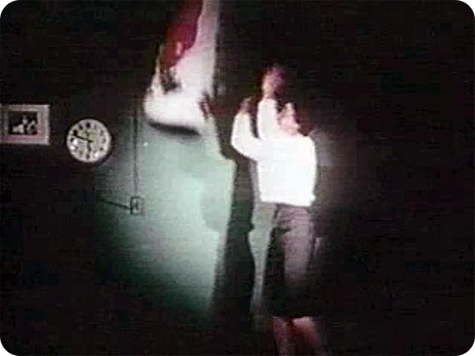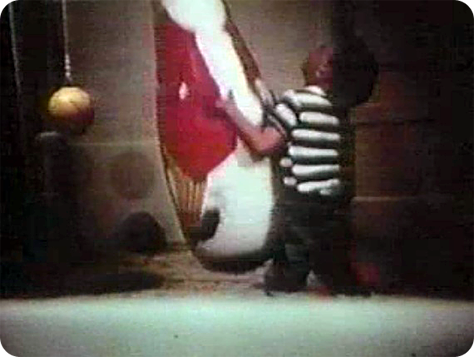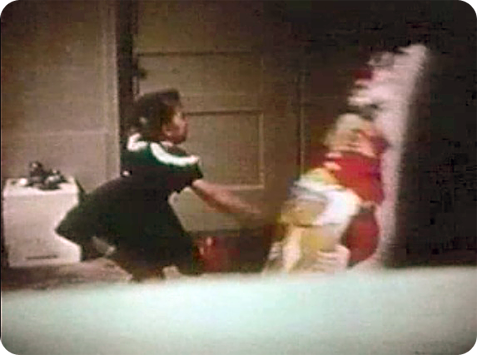
Chapter 1. MODELING: LEARNING BY OBSERVATION
Synopsis

MODELING:
LEARNING BY OBSERVATION

Author
Thomas E. Ludwig, Hope College
Synopsis
More than four decades ago, Albert Bandura and his colleagues conducted their now-classic experiments on observational learning and aggression. In this activity, you will view video clips from Bandura’s original Bobo experiments that show a model engaged in aggressive actions and children imitating the model. After observing the children’s behavior, you will identify the specific aggressive actions imitated by the children. The activity concludes with a discussion of Bandura’s findings on the general arousing effect of viewing aggression.
REFERENCES
Bandura, A., Ross, D., & Ross, S. A. (1961). Transmission of aggression through imitation of aggressive models. Journal of Abnormal and Social Psychology, 63, 575–582.
Bandura, A., Ross, D., & Ross, S. A. (1963). Imitation of film-mediated aggressive models. Journal of Abnormal and Social Psychology, 66, 3–11.
Introduction

More than four decades ago, Albert Bandura and his colleagues conducted their now-classic experiments on observational learning and aggression. These experiments used Bobo dolls—large inflatable dolls weighted with sand at the bottom—as the targets of aggression
In Bandura’s initial experiment, some young children watched an adult model hit the Bobo doll in a variety of ways and make aggressive remarks to the doll. Other young children saw the doll but were not exposed to the model’s aggressive behavior. Later, the researchers intentionally frustrated the children by removing the toys that they had been playing with. The researchers then left the frustrated children alone with the Bobo doll and filmed their behavior through a one-way mirror.
Click to enlarge the following flow chart, which summarizes the results of Bandura's experiment.
Results from Bandura’s Experiment

Can you guess what happened? Those children who had seen the model act aggressively (the experimental group) were much more likely to display aggressive behaviors toward the doll than were the other children (the control group). Even more interesting, the two groups differed in the type of aggression that they displayed. When children in the control group acted aggressively, they usually hit or punched the doll with their fists. When the children in the experimental group showed aggression, they often imitated the model’s specific aggressive remarks as well as the model’s specific and unusual aggressive behaviors.
These results show that direct rewards and punishments are not necessary for learning. Children can learn from modeling—that is, they learn to act aggressively just by watching another person’s behavior and can even learn specific novel behaviors from the model.
Click to enlarge the following flow chart, which summarizes the results of Bandura's experiment.
A Closer Look at Bandura’s Experiment

Let’s break Bandura’s experiment into its components. First, you will examine the actions of the model in a video clip that is part of the original footage from Bandura’s research. As you watch the video, pay close attention to the model’s behavior.
After watching the video, list the specific behaviors in the response fields below. Be sure to enter one behavior in each of the five answer boxes.
1.
Behavior 1:
Behavior 2:
Behavior 3:
Behavior 4:
Behavior 5:
A Closer Look at Bandura's Experiment (continued)





How well did you do? Did you notice each of the specific actions illustrated?
Here is the list of behaviors that you observed:
1.) No response entered.
2.) No response entered.
3.) No response entered.
4.) No response entered.
5.) No response entered.
Screenshot Credits:
Courtesy of Albert Bandura
© Worth Publishers
Observing the Children Who Observed the Model

You have seen the model's actions. Now let’s see how the children interacted with the Bobo doll after watching the model.
The next video shows more of the original video footage from Bandura's research. In this clip, you will see a young boy who participated in the experimental condition (exposed to the aggressive model). Pay close attention to his specific behaviors, and then list those behaviors in the response fields below.
Be sure to enter one behavior in each of the five answer boxes.
2.
Behavior 1:
Behavior 2:
Behavior 3:
Behavior 4:
Behavior 5:
The Boy’s Actions





How well did you do? Did you notice each of the specific actions illustrated?
Here is the list of behaviors that you observed:
1.) No response entered.
2.) No response entered.
3.) No response entered.
4.) No response entered.
5.) No response entered.
Screenshot Credits:
Courtesy of Albert Bandura
© Worth Publishers
Observing Another Child

Perhaps you were not surprised that the little boy imitated Bandura’s aggressive model, but would little girls do the same when put into a room with the Bobo doll? The next video clip, also from Bandura’s original footage, shows a young girl who participated in the experimental condition. Pay close attention to her specific behaviors, and then list those behaviors in the response fields below.
Be sure to enter one behavior in each of the five answer boxes.
3.
Behavior 1:
Behavior 2:
Behavior 3:
Behavior 4:
Behavior 5:
The Girl’s Actions






How well did you do? Did you notice each of the specific actions illustrated?
Here is the list of behaviors that you observed:
1.) No response entered.
2.) No response entered.
3.) No response entered.
4.) No response entered.
5.) No response entered.
Screenshot Credits:
Courtesy of Albert Bandura
© Worth Publishers
Inventing Novel Behaviors

It was clear from Bandura’s initial experiment that children could learn specific aggressive behaviors by watching a model, but Bandura also demonstrated that exposure to an aggressive model has a general arousing effect on the child leading the child to invent his or her own novel forms of violent behavior and display actions that go beyond mere imitation of the model.
In this final video, you will see one more clip of Bandura’s original video footage of children in the experimental group. Pay close attention to their specific behaviors.
These children did not see a model throw an object at the doll or point a gun at the doll. Nevertheless, the model’s aggression stimulated the children to initiate these new forms of violence on their own. Bandura concluded that children learn at least two things from observing an aggressive model: (1) how to perform the specific actions demonstrated by the model, and (2) the general point that aggression is an acceptable (and perhaps even enjoyable) form of behavior.
Assessment: Check Your Understanding

4.
1. In Bandura’s experiment, the control group had exactly the same experiences as the experimental group except that the children in the control group did not observe the model hitting the Bobo doll and making aggressive remarks toward it.
Assessment: Check Your Understanding

5.
2. When the children in Bandura’s experimental group were left alone with the doll, they were more likely to hit the doll than were the children in the control group.
Assessment: Check Your Understanding

6.
3. In Bandura’s experiment, both groups of children were equally likely to make aggressive remarks toward the doll.
Assessment: Check Your Understanding

7.
4. Bandura’s experiment showed that children will not only imitate the model’s specific aggressive behaviors but will also invent novel aggressive actions in their own spontaneous play.
Assessment: Check Your Understanding

8.
5. Can you think of any common “real-life” situations in which observational learning occurs? Provide several examples in the space below.
1.) an athletic aerobics instructor leads a class in an exercise routine;
2.) a teen accompanies her parents to an expensive restaurant and watches others to see which fork or spoon to use for each course;
3.) a young boy practices wrestling moves that he learned by watching professional wrestlers on television.
Activity results are being submitted...